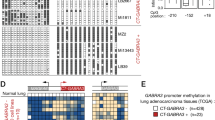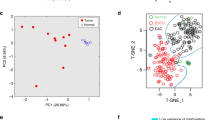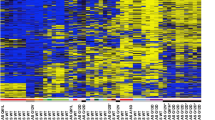Abstract
The maintenance cytosine DNA methyltransferase DNMT1 and de novo methyltransferase DNMT3b cooperate to establish aberrant DNA methylation and chromatin complexes to repress gene transcription during cancer development. The expression of DNMT3b was constitutively increased 5–20-fold in hTERT/CDK4-immortalized human bronchial epithelial cells (HBECs) before treatment with low doses of tobacco carcinogens. Overexpression of DNMT3b increased and accelerated carcinogen-induced transformation. Genome-wide profiling of transformed HBECs identified 143 DNMT3b-target genes, many of which were transcriptionally regulated by the polycomb repressive complex 2 (PRC2) complex and silenced through aberrant methylation in non-small-cell lung cancer cell lines. Two genes studied in detail, MAL and OLIG2, were silenced during transformation, initially through enrichment for H3K27me3 and H3K9me2, commonly methylated in lung cancer, and exert tumor suppressor effects in vivo through modulating cancer-related pathways. Re-expression of MAL and OLIG2 to physiological levels dramatically reduced the growth of lung tumor xenografts. Our results identify a key role for DNMT3b in the earliest stages of initiation and provide a comprehensive catalog of genes targeted for silencing by this methyltransferase in non-small-cell lung cancer.
This is a preview of subscription content, access via your institution
Access options
Subscribe to this journal
Receive 50 print issues and online access
$259.00 per year
only $5.18 per issue
Buy this article
- Purchase on Springer Link
- Instant access to full article PDF
Prices may be subject to local taxes which are calculated during checkout



Similar content being viewed by others
References
Greenlee RT, Hill-Harmon MB, Murray T, Thun M . Cancer statistics. CA Cancer J Clin 2001; 51: 15–36.
Janssen-Heijnen ML, Coebergh JW . The changing epidemiology of lung cancer in Europe. Lung Cancer 2003; 41: 245–258.
Baylin SB, Herman JG . DNA hypermethylation in tumorigenesis: epigenetics joins genetics. Trends Genet 2000; 16: 168–174.
Jones PA, Laird PW . Cancer epigenetics comes of age. Nat Genet 1999; 21: 163–167.
Tessema M, Yu YY, Stidley CA, Machida EO, Schuebel KE, Baylin SB et al. Concomitant promoter methylation of multiple genes in lung adenocarcinomas from current, former and never smokers. Carcinogenesis 2009; 30: 1132–1138.
Belinsky SA, Klinge DM, Stidley CA, Issa JP, Herman JG, March TH et al. Inhibition of DNA methylation and histone deacetylation prevents murine lung cancer. Cancer Res 2003; 63: 7089–7093.
Belinsky SA, Palmisano WA, Gilliland FD, Crooks LA, Divine KK, Winters SA et al. Aberrant promoter methylation in bronchial epithelium and sputum from current and former smokers. Cancer Res 2002; 62: 2370–2377.
Belinsky SA, Nikula KJ, Baylin SB, Issa JP . Increased cytosine DNA-methyltransferase activity is target-cell-specific and an early event in lung cancer. Proc Natl Acad Sci USA 1996; 93: 4045–4050.
Cancer Genome Atlas Research N, Comprehensive genomic characterization of squamous cell lung cancers. Nature 2012; 489: 519–525.
Saito Y, Kanai Y, Sakamoto M, Saito H, Ishii H, Hirohashi S . Expression of mRNA for DNA methyltransferases and methyl-CpG-binding proteins and DNA methylation status on CpG islands and pericentromeric satellite regions during human hepatocarcinogenesis. Hepatology 2001; 33: 561–568.
Robert MF, Morin S, Beaulieu N, Gauthier F, Chute IC, Barsalou A et al. DNMT1 is required to maintain CpG methylation and aberrant gene silencing in human cancer cells. Nat Genet 2003; 33: 61–65.
Fatemi M, Hermann A, Gowher H, Jeltsch A . Dnmt3a and Dnmt1 functionally cooperate during de novo methylation of DNA. Eur J Biochem 2002; 269: 4981–4984.
el-Deiry WS, Nelkin BD, Celano P, Yen RW, Falco JP, Hamilton SR et al. High expression of the DNA methyltransferase gene characterizes human neoplastic cells and progression stages of colon cancer. Proc Natl Acad Sci USA 1991; 88: 3470–3474.
Okano M, Bell DW, Haber DA, Li E . DNA methyltransferases Dnmt3a and Dnmt3b are essential for de novo methylation and mammalian development. Cell 1999; 99: 247–257.
Girault I, Tozlu S, Lidereau R, Bieche I . Expression analysis of DNA methyltransferases 1, 3A, and 3B in sporadic breast carcinomas. Clin Cancer Res 2003; 9: 4415–4422.
Yakushiji T, Uzawa K, Shibahara T, Noma H, Tanzawa H . Over-expression of DNA methyltransferases and CDKN2A gene methylation status in squamous cell carcinoma of the oral cavity. Int J Oncol 2003; 22: 1201–1207.
Gao Q, Steine EJ, Barrasa MI, Hockemeyer D, Pawlak M, Fu D et al. Deletion of the de novo DNA methyltransferase Dnmt3a promotes lung tumor progression. Proc Natl Acad Sci USA 2011; 108: 18061–18066.
Kim GD, Ni J, Kelesoglu N, Roberts RJ, Pradhan S . Co-operation and communication between the human maintenance and de novo DNA (cytosine-5) methyltransferases. EMBO J 2002; 21: 4183–4195.
Rhee I, Bachman KE, Park BH, Jair KW, Yen RW, Schuebel KE et al. DNMT1 and DNMT3b cooperate to silence genes in human cancer cells. Nature 2002; 416: 552–556.
Fuks F, Burgers WA, Brehm A, Hughes-Davies L, Kouzarides T . DNA methyltransferase Dnmt1 associates with histone deacetylase activity. Nat Genet 2000; 24: 88–91.
Fan H, Chen L, Zhang F, Quan Y, Su X, Qiu X et al. MTSS1, a novel target of DNA methyltransferase 3B, functions as a tumor suppressor in hepatocellular carcinoma. Oncogene 2012; 31: 2298–2308.
Ghoshal K, Motiwala T, Claus R, Yan P, Kutay H, Datta J et al. HOXB13, a target of DNMT3B, is methylated at an upstream CpG island, and functions as a tumor suppressor in primary colorectal tumors. PLoS One 2010; 5: e10338.
Linhart HG, Lin H, Yamada Y, Moran E, Steine EJ, Gokhale S et al. Dnmt3b promotes tumorigenesis in vivo by gene-specific de novo methylation and transcriptional silencing. Genes Dev 2007; 21: 3110–3122.
Damiani LA, Yingling CM, Leng S, Romo PE, Nakamura J, Belinsky SA . Carcinogen-induced gene promoter hypermethylation is mediated by DNMT1 and causal for transformation of immortalized bronchial epithelial cells. Cancer Res 2008; 68: 9005–9014.
Tellez CS, Juri DE, Do K, Bernauer AM, Thomas CL, Damiani LA et al. EMT and stem cell-like properties associated with miR-205 and miR-200 epigenetic silencing are early manifestations during carcinogen-induced transformation of human lung epithelial cells. Cancer Res 2011; 71: 3087–3097.
Shen X, Liu Y, Hsu YJ, Fujiwara Y, Kim J, Mao X et al. EZH1 mediates methylation on histone H3 lysine 27 and complements EZH2 in maintaining stem cell identity and executing pluripotency. Mol Cell 2008; 32: 491–502.
Copray S, Balasubramaniyan V, Levenga J, de Bruijn J, Liem R, Boddeke E . Olig2 overexpression induces the in vitro differentiation of neural stem cells into mature oligodendrocytes. Stem Cells 2006; 24: 1001–1010.
Zi X, Guo Y, Simoneau AR, Hope C, Xie J, Holcombe RF et al. Expression of Frzb/secreted Frizzled-related protein 3, a secreted Wnt antagonist, in human androgen-independent prostate cancer PC-3 cells suppresses tumor growth and cellular invasiveness. Cancer Res 2005; 65: 9762–9770.
Ligon KL, Huillard E, Mehta S, Kesari S, Liu H, Alberta JA et al. Olig2-regulated lineage-restricted pathway controls replication competence in neural stem cells and malignant glioma. Neuron 2007; 53: 503–517.
Mokhtari K, Paris S, Aguirre-Cruz L, Privat N, Criniere E, Marie Y et al. Olig2 expression, GFAP, p53 and 1p loss analysis contribute to glioma subclassification. Neuropathol App Neurobiol 2005; 31: 62–69.
Tabu K, Ohnishi A, Sunden Y, Suzuki T, Tsuda M, Tanaka S et al. A novel function of OLIG2 to suppress human glial tumor cell growth via p27Kip1 transactivation. J Cell Sci 2006; 119 (Pt 7): 1433–1441.
Tabu K, Ohba Y, Suzuki T, Makino Y, Kimura T, Ohnishi A et al. Oligodendrocyte lineage transcription factor 2 inhibits the motility of a human glial tumor cell line by activating RhoA. Mol Cancer Res 2007; 5: 1099–1109.
Yoo KH, Hennighausen L . EZH2 methyltransferase and H3K27 methylation in breast cancer. Int J Biol Sci 2012; 8: 59–65.
Vire E, Brenner C, Deplus R, Blanchon L, Fraga M, Didelot C et al. The Polycomb group protein EZH2 directly controls DNA methylation. Nature 2006; 439: 871–874.
Qi W, Chan H, Teng L, Li L, Chuai S, Zhang R et al. Selective inhibition of Ezh2 by a small molecule inhibitor blocks tumor cells proliferation. Proc Natl Acad Sci USA 2012; 109: 21360–21365.
Tessema M, Yingling CM, Snider AM, Do K, Picchi MA, Zhang X et al. GATA2 is epigenetically repressed in human and mouse lung tumors and is not requisite for survival of KRAS mutant lung cancer. J Thr Onc in press 2013.
Beaulieu N, Morin S, Chute IC, Robert MF, Nguyen H, MacLeod AR . An essential role for DNA methyltransferase DNMT3B in cancer cell survival. J Biol Chem 2002; 277: 28176–28181.
Mimori K, Shiraishi T, Mashino K, Sonoda H, Yamashita K, Yoshinaga K et al. MAL gene expression in esophageal cancer suppresses motility, invasion and tumorigenicity and enhances apoptosis through the Fas pathway. Oncogene 2003; 22: 3463–3471.
Cao W, Zhang ZY, Xu Q, Sun Q, Yan M, Zhang J et al. Epigenetic silencing of MAL, a putative tumor suppressor gene, can contribute to human epithelium cell carcinoma. Mol Cancer 2010; 9: 296.
Winklmeier A, Contreras-Shannon V, Arndt S, Melle C, Bosserhoff AK . Cadherin-7 interacts with melanoma inhibitory activity protein and negatively modulates melanoma cell migration. Cancer Sci 2009; 100: 261–268.
Marsit CJ, Houseman EA, Christensen BC, Gagne L, Wrensch MR, Nelson HH et al. Identification of methylated genes associated with aggressive bladder cancer. PLoS One 2010; 5: e12334.
Niehrs C, Acebron SP . Mitotic and mitogenic Wnt signalling. EMBO J 2012; 31: 2705–2713.
Alonso MA, Weissman SM . cDNA cloning and sequence of MAL, a hydrophobic protein associated with human T-cell differentiation. Proc Natl Acad Sci USA 1987; 84: 1997–2001.
Kim T, Fiedler K, Madison DL, Krueger WH, Pfeiffer SE . Cloning and characterization of MVP17: a developmentally regulated myelin protein in oligodendrocytes. J Neurosci Res 1995; 42: 413–422.
Horne HN, Lee PS, Murphy SK, Alonso MA, Olson JA Jr, Marks JR . Inactivation of the MAL gene in breast cancer is a common event that predicts benefit from adjuvant chemotherapy. Mol Cancer Res 2009; 7: 199–209.
Buffart TE, Overmeer RM, Steenbergen RD, Tijssen M, van Grieken NC, Snijders PJ et al. MAL promoter hypermethylation as a novel prognostic marker in gastric cancer. Br J Cancer 2008; 99: 1802–1807.
Pulling LC, Divine KK, Klinge DM, Gilliland FD, Kang T, Schwartz AG et al. Promoter hypermethylation of the O6-methylguanine-DNA methyltransferase gene: more common in lung adenocarcinomas from never-smokers than smokers and associated with tumor progression. Cancer Res 2003; 63: 4842–4848.
Hirano T, Franzen B, Kato H, Ebihara Y, Auer G . Genesis of squamous cell lung carcinoma. Sequential changes of proliferation, DNA ploidy, and p53 expression. Am J Pathol 1994; 144: 296–302.
Sato M, Larsen JE, Lee W, Sun H, Shames DS, Dalvi MP et al. Human lung epithelial cells progressed to malignancy through specific oncogenic manipulations. Mol Cancer Res 2013; 11: 638–650.
Tessema M, Klinge DM, Yingling CM, Do K, Van Neste L, Belinsky SA . Re-expression of CXCL14, a common target for epigenetic silencing in lung cancer, induces tumor necrosis. Oncogene 2010; 29: 5159–5170.
Acknowledgements
Data generated by The Cancer Genome Atlas (TCGA) project established by the NCI and NHGRI were used to validate part of our findings. The dbGaP accession number for TCGA data is phs000178.v8.p7. Information about TCGA and the investigators and institutions that constitute the TCGA research network can be found at http://cancergenome.nih.gov/. We acknowledge the following for technical support: Kieu Do, Randall Willink, Christopher Dagucon and Daniel E Juri. We also thank Dr Shuguang Leng for help with TCGA data acquisition, Dr Xiequn Zhang for help with bioinformatics analyses and Dr Julie Hutt for pathology review of xenografted tumors. This study was supported by NIH Grants R01 ES015262 to SAB and 1F32 CA157082 to IT.
Author information
Authors and Affiliations
Corresponding author
Ethics declarations
Competing interests
The authors declare no conflict of interest.
Additional information
Supplementary Information accompanies this paper on the Oncogene website
Rights and permissions
About this article
Cite this article
Teneng, I., Tellez, C., Picchi, M. et al. Global identification of genes targeted by DNMT3b for epigenetic silencing in lung cancer. Oncogene 34, 621–630 (2015). https://doi.org/10.1038/onc.2013.580
Received:
Revised:
Accepted:
Published:
Issue Date:
DOI: https://doi.org/10.1038/onc.2013.580
Keywords
This article is cited by
-
miR-203a-3p-DNMT3B feedback loop facilitates non-small cell lung cancer progression
Human Cell (2022)
-
Chromatin remodeling by the histone methyltransferase EZH2 drives lung pre-malignancy and is a target for cancer prevention
Clinical Epigenetics (2021)
-
Genome-wide association study across European and African American ancestries identifies a SNP in DNMT3B contributing to nicotine dependence
Molecular Psychiatry (2018)
-
Genome-wide DNA methylation profiling integrated with gene expression profiling identifies PAX9 as a novel prognostic marker in chronic lymphocytic leukemia
Clinical Epigenetics (2017)
-
Multidimensional integrative analysis uncovers driver candidates and biomarkers in penile carcinoma
Scientific Reports (2017)



